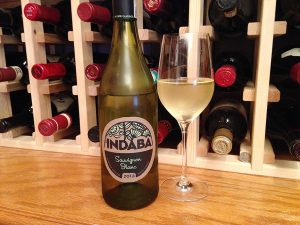Indaba Sauvignon Blanc Western Cape 2013: Light golden color; citrus nose, but not much aromatics and no cut grass;
pineapple, grapefruit, lotta lemon, lime, mango on the palate; cut grass grows a leaf or two on the finish; nice tangy acidity and minerality, no oak, light body, refreshing, food friendly. Simple, clean, straight-forward sauv blanc; this is South African value that delivers no wow but is completely serviceable pour-for-price. The Western Cape is the area most of us think about when we think South Africa; it is the largest of the nine provinces, the capitol is Cape Town, it includes the Cape of Good Hope, it also is area that produces most of South Africa’s wines. Principal grapes include Rhône-style reds and sauvignon blancs, plus steen (chenin blanc) and pinotage (the red variety created in South Africa in the 1920s that is, at its best wonderful and at its worst terrible, and thus always controversial). South African wine has deep history. The founder of Cape Town, Jan van Riebeeck, produced the first wines here in 1659. In general, South African wines provide excellent value-for-price, but they continue to struggle for United States market share, perhaps because of two-pronged prejudice: some folks still recoil at South Africa’s racist past (forget Nelson Mandela was president of the country in the 1990s), others do not believe a black country really could make good wine, both ideas are deeply flawed in the 21st century. Visit South African wine websites and you will see white and black winemakers working side-by-side making excellent wine. Ask your local wine seller to stock more South African wines; you wallet and your palate will thank you. $11 
